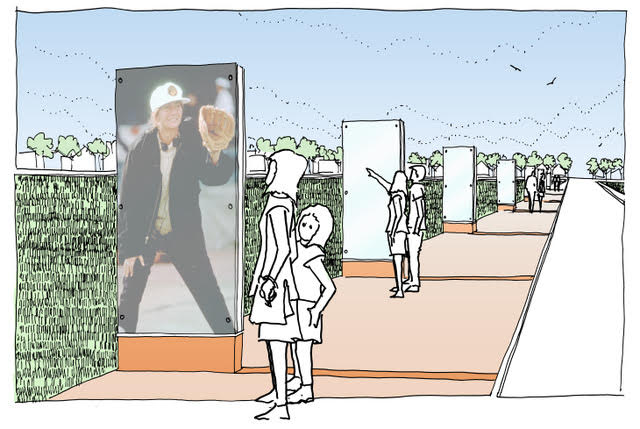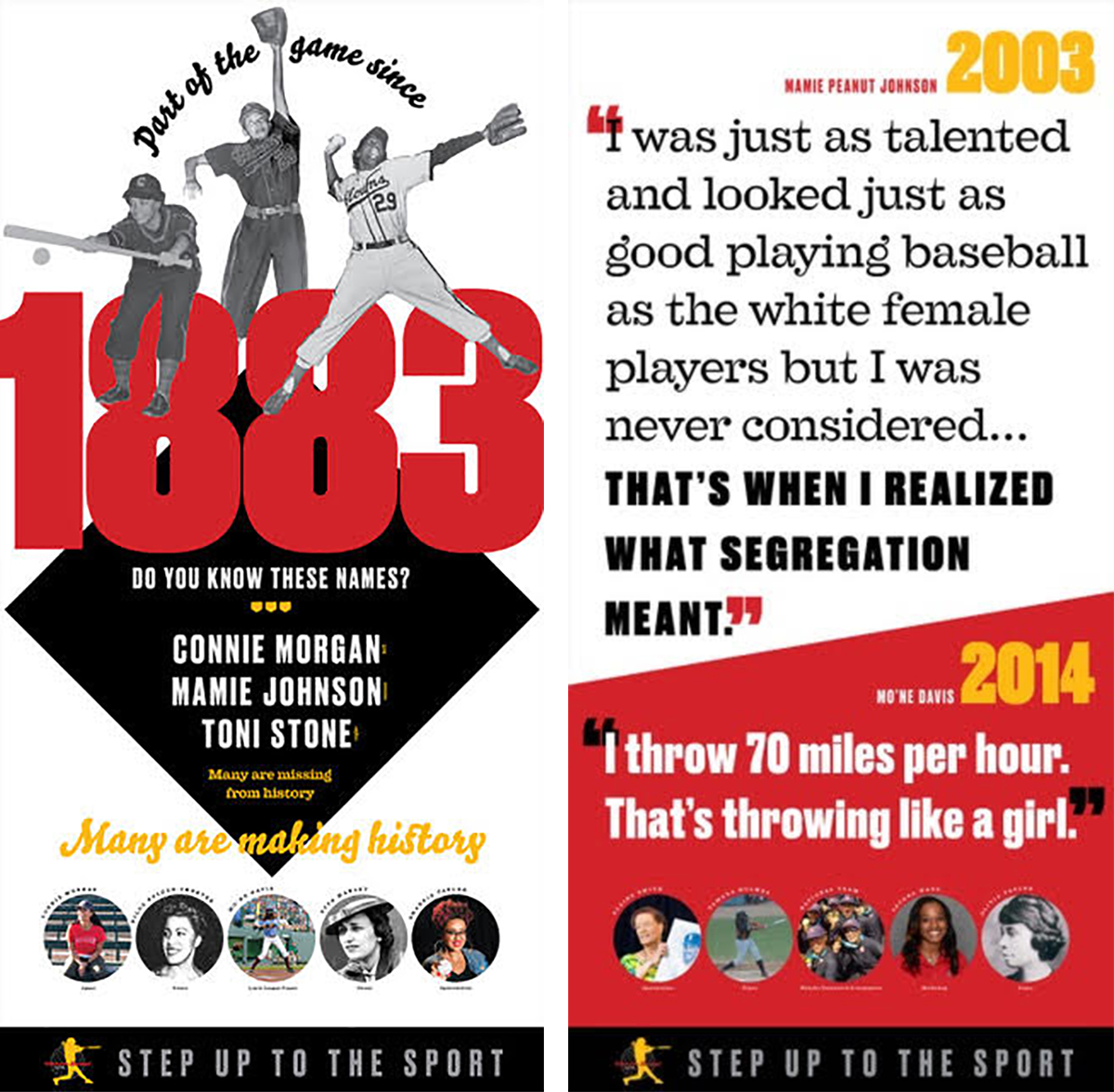IWBC unveils memorial dedicated to African American women in baseball
An artist’s rendering of nine planned historical markers at the future International Women’s Baseball Center outdoor museum in Rockford, Illinois. (COURTESY OF RENA SOKOLOW)
By Peter Warren
The International Women’s Baseball Center unveiled a historical marker designed to honor the contributions of African American women in baseball during the second annual SABR/IWBC Women in Baseball Conference.
The second of nine planned pylons for the IWBC’s future outdoor museum in Rockford, Illinois, the memorial was presented following the Negro Leagues Centennial Celebration on September 12, 2020.
“In most written history, most stories that are re-told, and most movies that are made, women of color have simply been ignored or given a cursory nod,” IWBC president Kat Williams said in a pre-recorded video that aired during the virtual conference. “That stops now. What they did, what they do, matters. Their legacy is our legacy. And until women of color are given the acknowledgment and the honor they deserve in the game of baseball, what we think we know about the game of baseball and girls and women’s participation in it is simply wrong.”
The pylon features the photographs of 13 different African American women who have made an impact in baseball:
- Hilda Bolden-Shorter, owner of the Negro League Philadelphia Stars from 1950-1952
- Mo’ne Davis, star pitcher of the Mid-Atlantic Team in the 2014 Little League World Series and current softball player at Hampton University
- Tamara Holmes, a power-hitting outfielder for the Colorado Silver Bullets in 1997 and United States national team for over a decade
- Mamie “Peanut” Johnson, a great pitcher for the Negro League’s Indianapolis Clowns in the mid-1950s and one of three women to play at the highest level of the Negro Leagues
- Effa Manley, owner of the Newark Eagles for 13 years and currently the only woman elected to the Baseball Hall of Fame
- Connie Morgan, a second baseman for the Indianapolis Clowns in 1954-55 and one of three women to play at the highest level of the Negro Leagues
- Lonnie Murray, an MLBPA-certified agent and CEO of Sports Management Partners
- Claire Smith, the first woman to receive the J.G. Taylor Spink Award who has worked for the Hartford Courant, the New York Times, Philadelphia Inquirer, and ESPN
- Toni Stone, the first woman to ever play in the highest levels of the Negro Leagues as a member of the Indianapolis Clowns
- Olivia Taylor, a co-owner of the Indianapolis ABCs before serving as the sole owner for three seasons in the 1920s
- Shakeia Taylor, a baseball writer from Chicago who has been published in Baseball Prospectus, SB Nation, and The Hardball Times
- Malaika Underwood, an infielder for the United States national team and five-time IBAF Women’s Baseball World Cup medalist
- Jacara Ware, Senior Coordinator for Marketing & Advertising for the Arizona Diamondbacks
The selection of women from different eras and different fields within the game was a consensus decision by the IWBC.
“You don’t want it to be focused on just one person to represent whatever the topic is,” said Leslie Heaphy, SABR Vice President and chair of SABR’s Women in Baseball committee. “What was really important to us this year was to make sure we had a wide representation of different roles, and not just to imply that it was about just players or just owners or something like that.”
On one side of the pylon, Johnson, Morgan, and Stone are featured prominently with large photos of each other. Surrounding the photos are statements such as “Do you know these names?” and “Many are missing from history.”
Shakeia Taylor was watching the unveiling online when she saw her photo pop up on the same side of the pylon as Johnson, Morgan, and Stone. She had been asked to submit a photo of herself but thought it was going to be used for a conference booklet and not for the pylon.
in the list of Black women throughout the history of baseball, my name was just mentioned.
i literally shouted, “HEY, THAT’S ME!”
what an honor. thank you, @sabr and @IWBC4Me!
— sugar shake (@curlyfro) September 12, 2020
“I’m still processing it,” Taylor said. “I hope that it’s inspiring for someone else. … It’s super cool to know that my name kind of goes up in the history of baseball right now.”
On the flip side of the pylon, two quotes take center stage. One is a statement made by Mamie Johnson in 2003: “I was just as talented and looked just as good playing baseball as the white female players but I was never considered. … That’s when I realized what segregation meant.”
The other is from Mo’ne Davis after one of her many magnificent performances during the 2014 Little League World Series: “I throw 70 miles per hour. That’s throwing like a girl.”
“(Johnson’s quote is) just very powerful to me and I felt like it was really important to put this out there for people to see in big type,” pylon designer Rena Sokolow said. “And then (the quote from) Mo’ne Davis … is also just so powerful and important. In this case, I really wanted those voices to be heard.”
The decision to design a pylon dedicated to African Americans was an easy one, Heaphy and Williams said. There had always been a plan to have a pylon on the topic, and the Centennial Celebration of the Negro Leagues in 2020 made it a “perfect match.”
The IWBC hopes the pylon can serve as an inspiration for women who want to enter the baseball industry and serve as a reminder that baseball is, and never was, just a game for people who are white and male.
“Women have always been part of the game,” Williams said, “and more importantly, right now, women of color have always been part of the game.”
For more coverage of the SABR/IWBC Women in Baseball Conference, click here.
Originally published: September 22, 2020. Last Updated: September 22, 2020.




